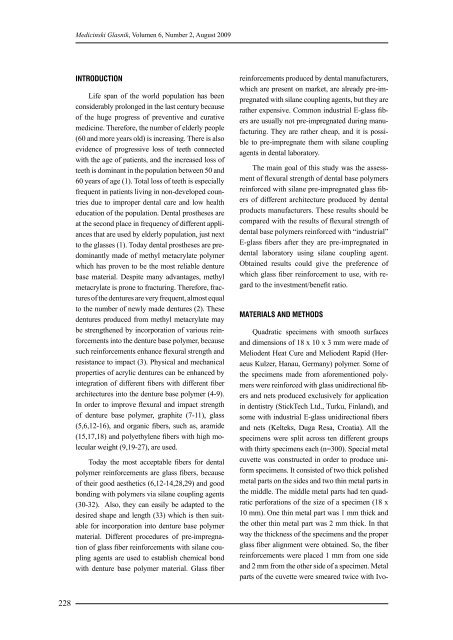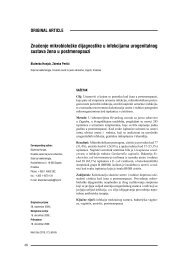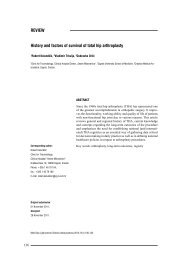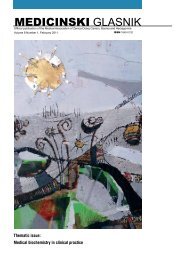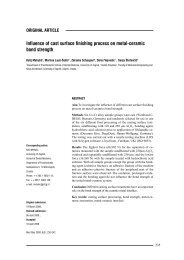MEDICINSKI GLASNIK
MEDICINSKI GLASNIK
MEDICINSKI GLASNIK
You also want an ePaper? Increase the reach of your titles
YUMPU automatically turns print PDFs into web optimized ePapers that Google loves.
228<br />
Medicinski Glasnik, Volumen 6, Number 2, August 2009<br />
INTRODUCTION<br />
Life span of the world population has been<br />
considerably prolonged in the last century because<br />
of the huge progress of preventive and curative<br />
medicine. Therefore, the number of elderly people<br />
(60 and more years old) is increasing. There is also<br />
evidence of progressive loss of teeth connected<br />
with the age of patients, and the increased loss of<br />
teeth is dominant in the population between 50 and<br />
60 years of age (1). Total loss of teeth is especially<br />
frequent in patients living in non-developed countries<br />
due to improper dental care and low health<br />
education of the population. Dental prostheses are<br />
at the second place in frequency of different appliances<br />
that are used by elderly population, just next<br />
to the glasses (1). Today dental prostheses are predominantly<br />
made of methyl metacrylate polymer<br />
which has proven to be the most reliable denture<br />
base material. Despite many advantages, methyl<br />
metacrylate is prone to fracturing. Therefore, fractures<br />
of the dentures are very frequent, almost equal<br />
to the number of newly made dentures (2). These<br />
dentures produced from methyl metacrylate may<br />
be strengthened by incorporation of various reinforcements<br />
into the denture base polymer, because<br />
such reinforcements enhance flexural strength and<br />
resistance to impact (3). Physical and mechanical<br />
properties of acrylic dentures can be enhanced by<br />
integration of different fibers with different fiber<br />
architectures into the denture base polymer (4-9).<br />
In order to improve flexural and impact strength<br />
of denture base polymer, graphite (7-11), glass<br />
(5,6,12-16), and organic fibers, such as, aramide<br />
(15,17,18) and polyethylene fibers with high molecular<br />
weight (9,19-27), are used.<br />
Today the most acceptable fibers for dental<br />
polymer reinforcements are glass fibers, because<br />
of their good aesthetics (6,12-14,28,29) and good<br />
bonding with polymers via silane coupling agents<br />
(30-32). Also, they can easily be adapted to the<br />
desired shape and length (33) which is then suitable<br />
for incorporation into denture base polymer<br />
material. Different procedures of pre-impregnation<br />
of glass fiber reinforcements with silane coupling<br />
agents are used to establish chemical bond<br />
with denture base polymer material. Glass fiber<br />
reinforcements produced by dental manufacturers,<br />
which are present on market, are already pre-impregnated<br />
with silane coupling agents, but they are<br />
rather expensive. Common industrial E-glass fibers<br />
are usually not pre-impregnated during manufacturing.<br />
They are rather cheap, and it is possible<br />
to pre-impregnate them with silane coupling<br />
agents in dental laboratory.<br />
The main goal of this study was the assessment<br />
of flexural strength of dental base polymers<br />
reinforced with silane pre-impregnated glass fibers<br />
of different architecture produced by dental<br />
products manufacturers. These results should be<br />
compared with the results of flexural strength of<br />
dental base polymers reinforced with “industrial”<br />
E-glass fibers after they are pre-impregnated in<br />
dental laboratory using silane coupling agent.<br />
Obtained results could give the preference of<br />
which glass fiber reinforcement to use, with regard<br />
to the investment/benefit ratio.<br />
MATERIALS AND METHODS<br />
Quadratic specimens with smooth surfaces<br />
and dimensions of 18 x 10 x 3 mm were made of<br />
Meliodent Heat Cure and Meliodent Rapid (Heraeus<br />
Kulzer, Hanau, Germany) polymer. Some of<br />
the specimens made from aforementioned polymers<br />
were reinforced with glass unidirectional fibers<br />
and nets produced exclusively for application<br />
in dentistry (StickTech Ltd., Turku, Finland), and<br />
some with industrial E-glass unidirectional fibers<br />
and nets (Kelteks, Duga Resa, Croatia). All the<br />
specimens were split across ten different groups<br />
with thirty specimens each (n=300). Special metal<br />
cuvette was constructed in order to produce uniform<br />
specimens. It consisted of two thick polished<br />
metal parts on the sides and two thin metal parts in<br />
the middle. The middle metal parts had ten quadratic<br />
perforations of the size of a specimen (18 x<br />
10 mm). One thin metal part was 1 mm thick and<br />
the other thin metal part was 2 mm thick. In that<br />
way the thickness of the specimens and the proper<br />
glass fiber alignment were obtained. So, the fiber<br />
reinforcements were placed 1 mm from one side<br />
and 2 mm from the other side of a specimen. Metal<br />
parts of the cuvette were smeared twice with Ivo-


